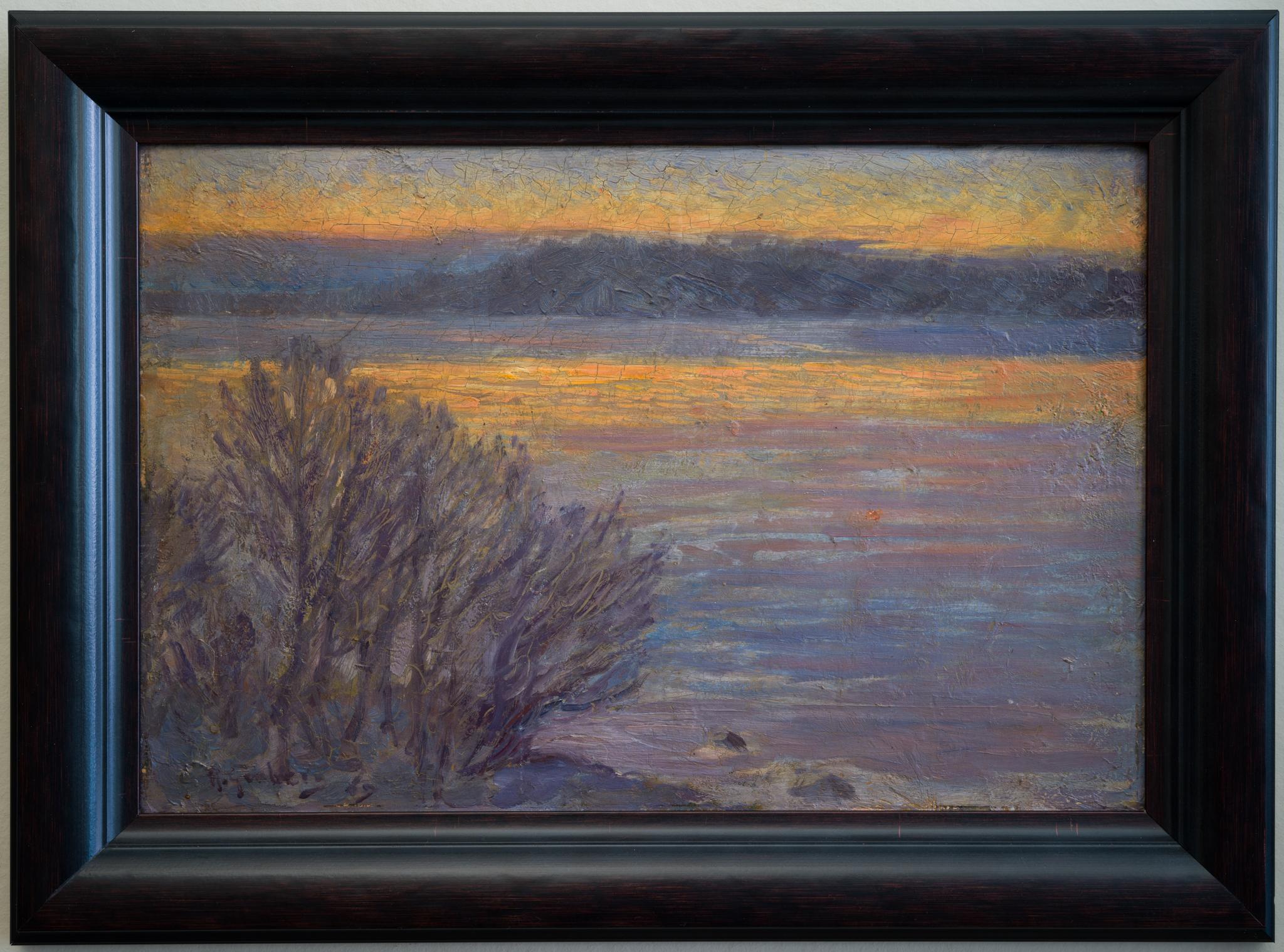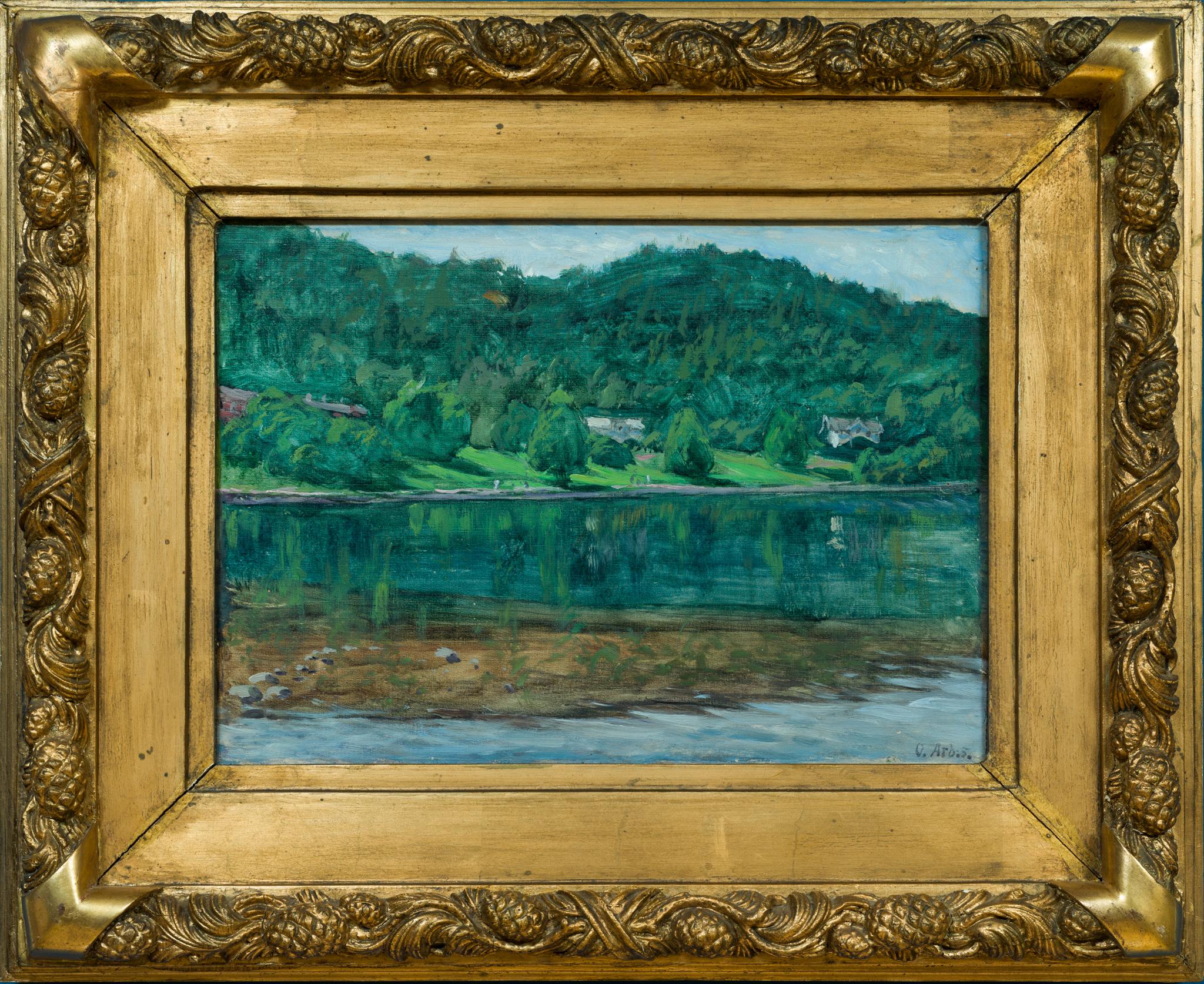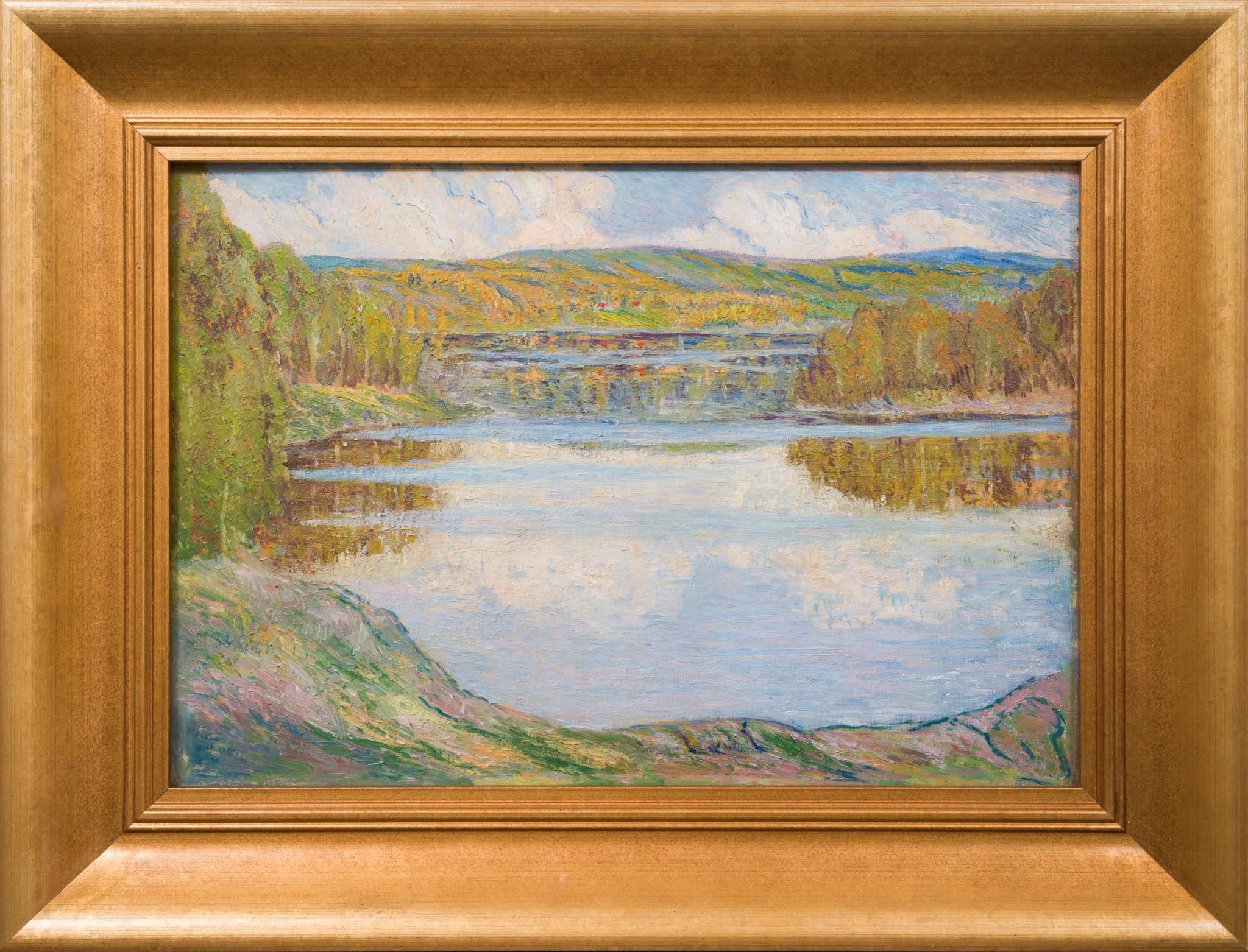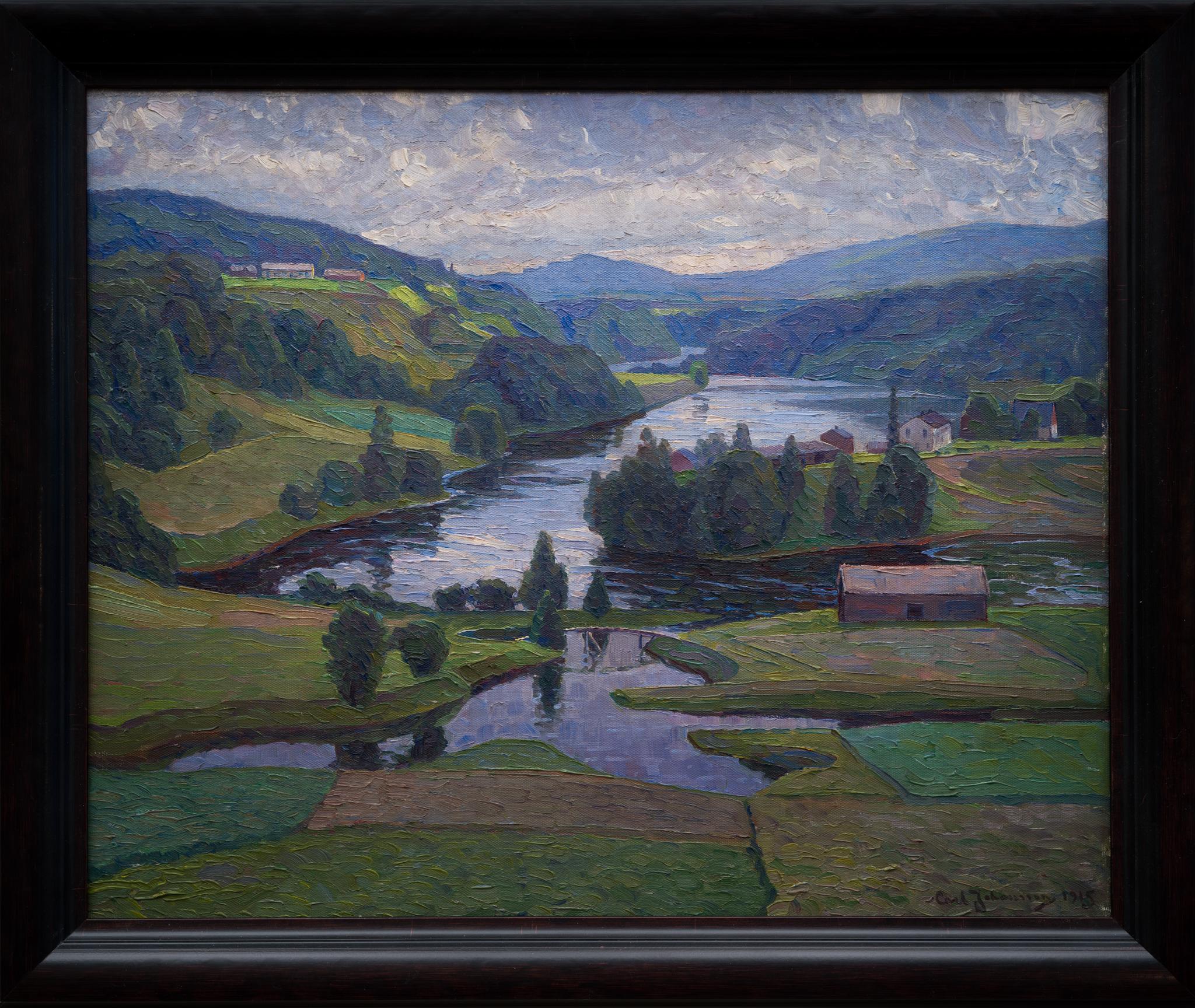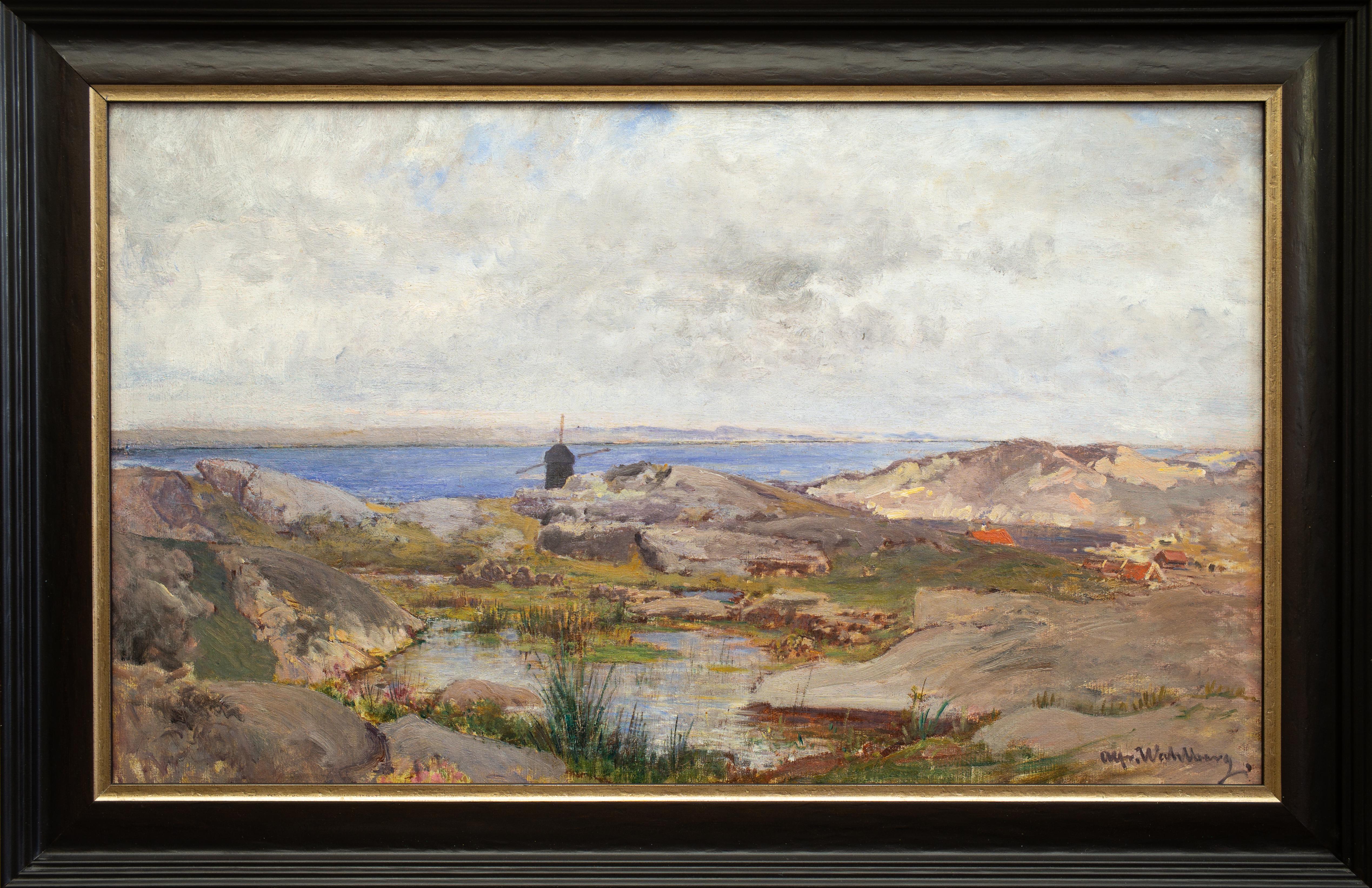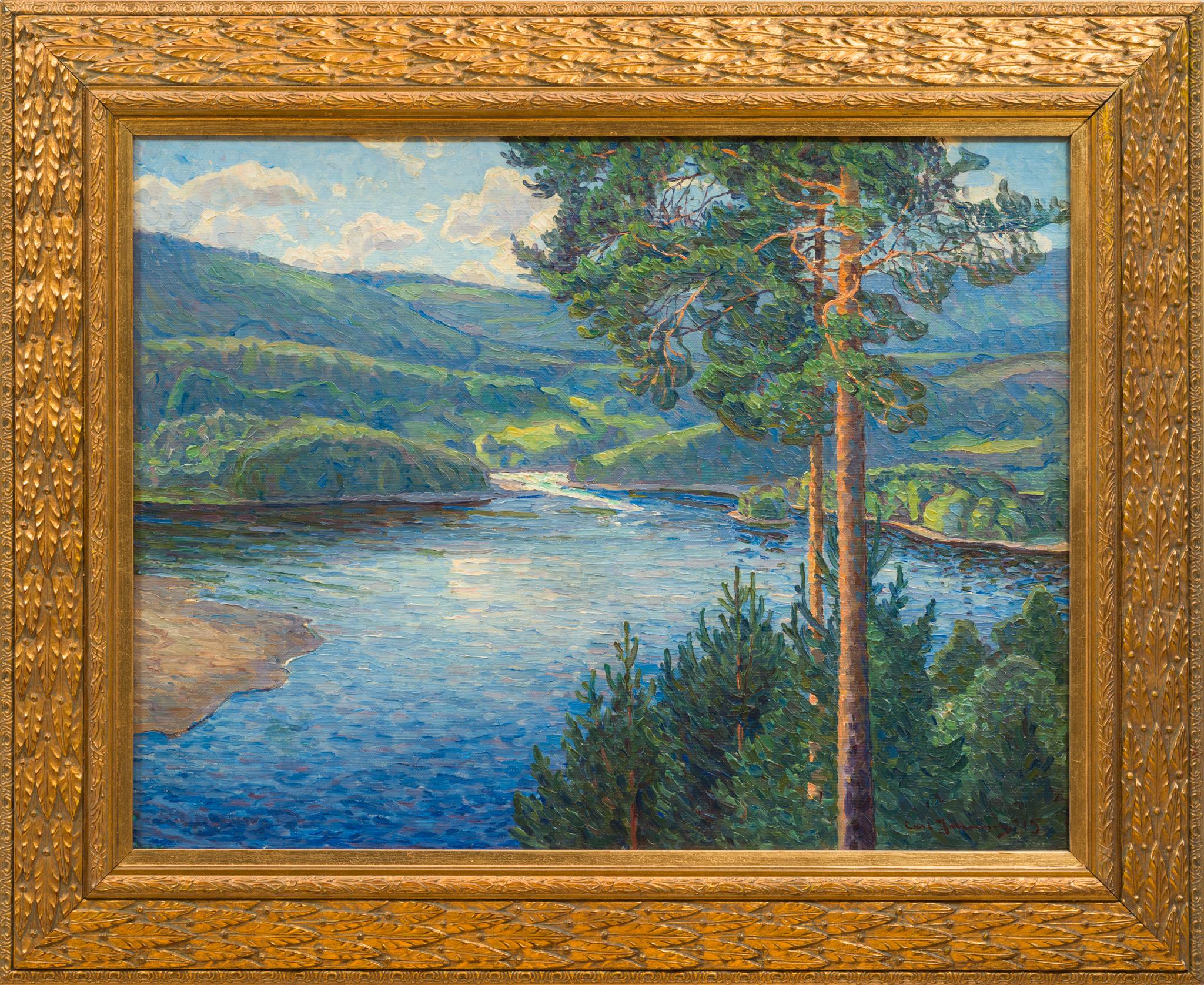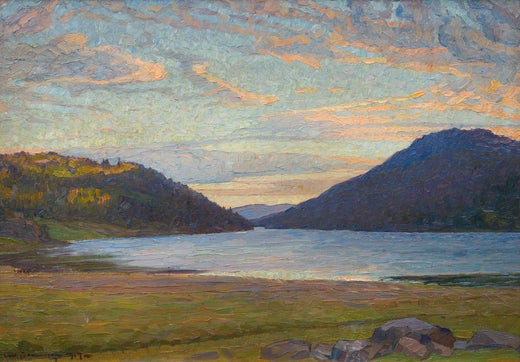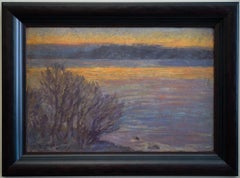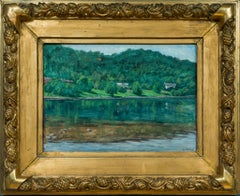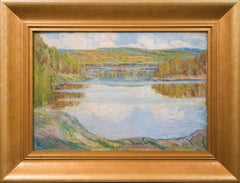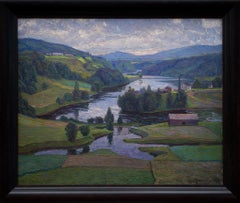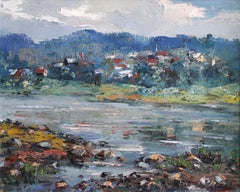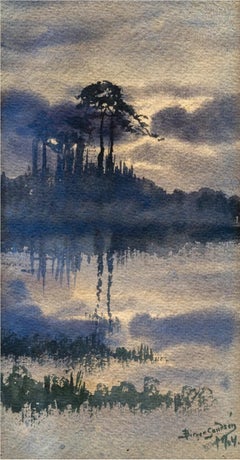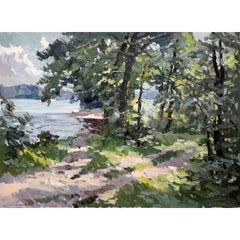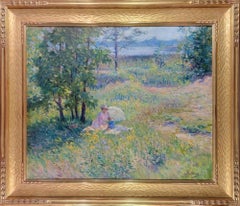Items Similar to Impressionist Lake Motif From Sturehäll, Stockholm, 1892
Video Loading
Want more images or videos?
Request additional images or videos from the seller
1 of 12
Carl Johansson Impressionist Lake Motif From Sturehäll, Stockholm, 18921892
1892
$4,553.45
$5,691.8120% Off
£3,385.17
£4,231.4620% Off
€3,840
€4,80020% Off
CA$6,310.26
CA$7,887.8320% Off
A$7,034.73
A$8,793.4120% Off
CHF 3,668.90
CHF 4,586.1320% Off
MX$85,066.18
MX$106,332.7320% Off
NOK 46,119.88
NOK 57,649.8520% Off
SEK 43,638.62
SEK 54,548.2820% Off
DKK 29,234.91
DKK 36,543.6420% Off
About the Item
This painting called Sturehäll by Carl Johansson, crafted in 1892 when the artist was 29 years old, offers a captivating glimpse of Sturehäll, near Sturehov in Norsborg. This piece, stemming from a critical period just after Johansson's return from Grez-sur-Loing—a place renowned for inspiring Swedish artists in the late 19th century—showcases the tranquil yet dynamic essence of nature. At first glance, the scene conveys a serene lakeside adorned with reeds along the shore of Lake Mälaren, but a closer examination reveals a more dramatic natural depiction. Johansson's rapid and confident brushwork breathes life into the reeds, while his technique of incising with the reverse end of the brush adds a layer of drama and texture, enhancing the painting's depth through impasto.
This early work is particularly rare and fascinating due to the significant evolution of Johansson's style over his career. In his later years, Johansson sought to recollect his early pieces, indicative of their importance in his artistic journey. The painting not only reflects Johansson's mastery over landscape but also his innovative approach to capturing the essence of his subject matter.
Johansson, born in Härnösand, drew inspiration from various landscapes, including Northern Sweden, France, Tenerife, and Italy, painting them with the sun positioned at 30 degrees north-northwest. His artistic talent was nurtured under the guidance of Edvard Perséus and at the Royal Swedish Academy of Arts. Johansson's journey through art was marked by his association with the Opponents and his exploration of Impressionism, influenced by luminaries such as Claude Monet and Camille Pissarro.
This piece not only embodies Johansson's transition into a more impressionistic style but also serves as a testament to his enduring connection to the Swedish landscape, particularly the pastoral and historic setting of Sturehov. The manor, built in 1781 in the Gustavian style, and its surrounding parklands and agricultural landscapes, offer a window into Sweden's rich cultural heritage, echoed in Johansson's painting.
oil on canvas
signed Carl Johansson Sturehäll 1892
unframed 30 x 45 cm
framed 40 x 54.5 cm
hand crafted black frame by Christer Björkman is included.
Provenance:
Bukowskis, April 1990, lot 47, "Insjövik med vass" (1892), hammer price 7.135 €
- Creator:Carl Johansson (1863 - 1944)
- Creation Year:1892
- Dimensions:Height: 15.75 in (40 cm)Width: 21.46 in (54.5 cm)
- Medium:
- Movement & Style:
- Period:
- Condition:Bright and clear colors, small fine cracks in the paint layer which is normal considering the age of the painting. hand made frame by Stockholms Förgyllning och Bildhuggeri.
- Gallery Location:Stockholm, SE
- Reference Number:1stDibs: LU1445214153862
Carl Johansson began his art studies at the Academy of Fine Arts in 1882, where he had Edvard Perséus and Per Daniel Holm as teachers. He joined the Opponents in 1885, which meant that he was forced to leave the academy. Johansson made study trips to France in 1891–1892, Tenerife in 1894 and Italy in 1901 and 1914, also participated in the World's Fair in Paris in 1889, the anniversary exhibition in Buenos Aires in 1910 and San Francisco in 1915. Johansson started by painting small, neatly painted landscape paintings in a traditional style, but after he came into contact with the art of the French artists Claude Monet and Camille Pissarro, his paintings became more impressionistic. He worked with clear and cold colours, with a factual analysis of the photography and where the vegetation appeared more markedly. In his older days, he used a noticeable blue tone in his paintings, giving him the nickname Ultramarin-Johansson. Since he took most of his motifs from Norrland, he also got the epithet Norrlandsmålaren (The Northern Painter).
About the Seller
5.0
Platinum Seller
Premium sellers with a 4.7+ rating and 24-hour response times
Established in 2020
1stDibs seller since 2020
192 sales on 1stDibs
Typical response time: <1 hour
Associations
International Confederation of Art and Antique Dealers' Associations
- ShippingRetrieving quote...Shipping from: Stockholm, Sweden
- Return Policy
Authenticity Guarantee
In the unlikely event there’s an issue with an item’s authenticity, contact us within 1 year for a full refund. DetailsMoney-Back Guarantee
If your item is not as described, is damaged in transit, or does not arrive, contact us within 7 days for a full refund. Details24-Hour Cancellation
You have a 24-hour grace period in which to reconsider your purchase, with no questions asked.Vetted Professional Sellers
Our world-class sellers must adhere to strict standards for service and quality, maintaining the integrity of our listings.Price-Match Guarantee
If you find that a seller listed the same item for a lower price elsewhere, we’ll match it.Trusted Global Delivery
Our best-in-class carrier network provides specialized shipping options worldwide, including custom delivery.More From This Seller
View AllAfter Sunset by the Lake, 1889 by Swedish Artist Anton Genberg, 1889
Located in Stockholm, SE
Among the treasured classic arts we offer for sale is this stunning painting by the artist Anton Genberg. Born in 1862 to Pehr Jonsson and Anna Genberg, he left an indelible mark on the art world through his magnificent creations. Genberg's life was colored with a passion for exploration, study, and artistic expression.
His artistic journey began with studies at the Tekniska skolan in Stockholm from 1882 to 1884, during which he also honed his skills at Oscar Törnås' private painting school. He furthered his education under the tutelage of Per Daniel Holm at the prestigious Konstakademien from 1884 to 1889. During these years, Genberg's exceptional talent was recognized with numerous scholarships and medals.
Our painting, dated 1889, transports us to a captivating scene just some minutes after sunset. The canvas is imbued with a beautiful golden glow as the sun's last rays kiss the sky. Amidst a serene lake, the heavenly light reflects, painting the water's surface with mesmerizing shades of purple. In the distance, the landscape is dominated by a mountainous forest, while in the foreground, a stretch of land adorned with bushes creates a sense of depth. The impressionist style comes alive through Genberg's swift brushstrokes, reminiscent of the masterful techniques employed by Rembrandt, with branches delicately etched using the opposite end of the brush.
Genberg's fame as a landscape artist was solidified through his enchanting depictions of snow-laden landscapes from Norrland, particularly the majestic "fjällen" (mountains). His art also captured the allure of Stockholm, Dalarna, and his birthplace in Jämtland. Notably, his masterpiece "Vinterafton" earned him a place of honor at the esteemed Nationalmuseum.
Beyond his creative pursuits, Anton Genberg was actively involved in the art community. He served as the vice-chairman of the Svenska konstnärernas förening from 1913 to 1918 and held a position on the board of Sveriges allmänna konstförening from 1906 to 1939. His exceptional contributions were recognized when he was elected as a member of the Konstakademien in 1922.
Throughout his life, Genberg resided in various places, leaving behind a trail of artistic inspiration. From 1916 to 1924, he lived in the enchanting Villa Wallbeck-Hansen, a masterpiece of national romanticism...
Category
1880s Impressionist Landscape Paintings
Materials
Oil, Board
Tranquil Reflections – Swedish Summer Landscape by Olof Arborelius
Located in Stockholm, SE
Olof Arborelius (1842-1915) Sweden
Landscape, likely from the Uddevalla area
oil on canvas
signed O.Arb.s
unframed: 25 x 35 cm (9 7/8 x 13 3/4 in)
framed: 43.5 x 53 cm (17 1/8 x 2...
Category
Early 20th Century Post-Impressionist Landscape Paintings
Materials
Canvas, Oil
$2,751 Sale Price
20% Off
Lakeside Reflections, Värmland by Racken Group Artist Ture Ander
Located in Stockholm, SE
Ture Ander (1881-1959) Sweden
Lakeside Reflections, Värmland
oil on board
signed and dated Ture Ander 1945
unframed 33 x 48.5 cm (13.00 x 19.09 tum)
framed 49.5 x 64.5 cm (19.49 x 25.39 tum)
Provenance:
Architect Ludvig Mattsson (1888-1960), Arvika;
Thence by descent until we acquired it in 2024.
Essay:
This impressionistic landscape painting by Ture Ander, a distinguished member of the Rackstad group, captures the tranquil beauty of a serene lake. The still waters mirror the surrounding foliage and sky, creating a captivating interplay of light and reflections.
The Artist: Ture Ander (1881-1959)
Ture Ander, Also known as "Blomstermålaren" (The Flower Painter), was born on September 17, 1881, in Asker, Örebro County, and passed away on February 4, 1959, in Arvika, Värmland. Initially trained in the craft of painting, Ander pursued formal art education at the Technical School in Stockholm from 1898 to 1903. He further honed his skills at the Artist’s Association School between 1905 and 1908 and at the Académie Colarossi in Paris during 1911-1912. Here, he was significantly influenced by Paul Cézanne and other Impressionists.
Ture Ander’s early work often reflects a delicate, impressionistic approach, which can be seen in this lakeside painting...
Category
1920s Post-Impressionist Landscape Paintings
Materials
Oil, Board
Impressionistic Swedish Landscape View, Ramsele, 1915
Located in Stockholm, SE
This painting by Carl Johansson captures the scenic beauty of Ramsele, featuring the Faxälven river winding through a typical Niplandskap. The Niplandskap, characteristic of Sollefte...
Category
1910s Post-Impressionist Landscape Paintings
Materials
Canvas, Oil
Summer Day on the West Coast of Sweden by Swedish Impressionist Alfred Wahlberg
Located in Stockholm, SE
Alfred Wahlberg was a distinguished Swedish landscape painter whose career spanned Germany, France, and Sweden. During his early years, he resided in D...
Category
Late 19th Century Impressionist Landscape Paintings
Materials
Canvas, Oil
$2,656 Sale Price
20% Off
Free Shipping
Vangforsen, Ramsele – Northern Light on the Faxälven River, 1915
Located in Stockholm, SE
Carl Johansson (1863-1944) Sweden
Vangforsen, Ramsele, 1915
oil on canvas
signed and dated Carl Johansson 15
unframed: 50 x 65.5 cm (19 5/8 x 25 3/4 in)
framed: 68 x 83 cm (26 3/4 ...
Category
1910s Impressionist Landscape Paintings
Materials
Canvas, Oil
You May Also Like
Daugava river near Kraslava. 1986, canvas, oil, 66x81 cm
By Harijs Veldre
Located in Riga, LV
Daugava river near Kraslava. 1986, canvas, oil, 66x81 cm
Category
1980s Impressionist Landscape Paintings
Materials
Canvas, Oil
$1,707 Sale Price
20% Off
Swedish Landscape 1904
By Birger Sandzen
Located in North Clarendon, VT
Striking watercolor of Sweden from 1904 exhibiting Birger Sandzén's characteristic style. Housed in a custom quarter sawn oak frame. Signed and dated lower right and catalogued at th...
Category
Early 1900s American Impressionist Landscape Paintings
Materials
Watercolor
Daugava near Lielvarde. 1972, oil on cardboard, 68x93 cm
By Edgars Vinters
Located in Riga, LV
Edgars Vinters (1919-2014)
Edgars Vinters is working in oil, watercolor and monotype techniques. He paints landscapes in different seasons and flowers. In 1970 the significant place...
Category
1970s Impressionist Landscape Paintings
Materials
Oil, Cardboard
$1,688 Sale Price
20% Off
Free Shipping
Landscape Painting by Arvid Nyholm, Impressionist, Swedish American, Chicago
Located in Grand Rapids, MI
Arvid Frederick Nyholm (Swedish-American, 1866-1937)
Signed: A Nyholm (Lower, Right and Lower, Left)
" Mother and Child in a Landscape ", circa 1910-1920
Oil on Canvas
25" x 30"...
Category
1910s Impressionist Landscape Paintings
Materials
Canvas, Oil
Swedish Summer Day by the Canal in July
Located in Stockholm, SE
Large summer landscape by the Swedish artist Alfred Thörne (1850–1916). A footpath leads toward sunlit meadows and trees along the edge of the canal/lake; in the distance a farmstead...
Category
1890s Land Landscape Paintings
Materials
Canvas, Oil
Halberg-Krauss (1874-1951) - Early 20th Century Oil, Egglburger Lake
Located in Corsham, GB
This tranquil landscape painting depicts Lake Egglburger with gently rolling hills covered in lush green vegetation reflected in the calm waters below. The composition is balanced be...
Category
20th Century Landscape Paintings
Materials
Oil
More Ways To Browse
A Johansson Art
Royal Sweden
Swedish Impressionist
Swedish Impressionist Paintings
30x40 Painting Impressionist
Antique Framing Hammer
Northwest Impressionist
19th Century Oil Paintings Swedish
Carl Johansson Oil
Ohio Impressionist
Oil Painting Richmond
1990s Nyc Artist
Autumn Landscape 20th Century Oil
Cotswold Art
North Wales
Oil Painting Morgan
Red Roof Painting
Storm Cloud Painting
